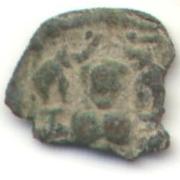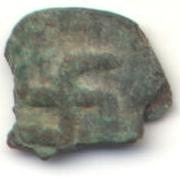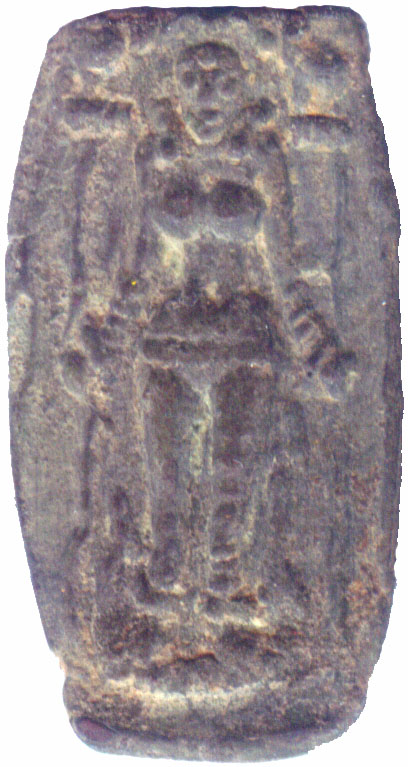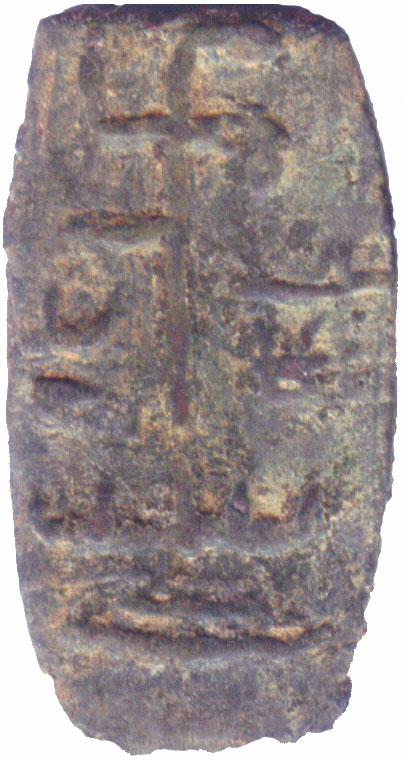1st - 3rd Century CE - Lanka
Anuradhapura Period - `Lakshmi' Plaques
A plaque with a standing female bathed by two elephants on obverse and
a railed Svastika on reverse. The shape is usually oblong, but in the
broader specimens is distinctly oval. They are either struck in
copper or cast in a lead based alloy which is brittle
and flakes easily.
The identity of the female as "Lakshmi" goddess of prosperity
can been questioned as she is always depicted with 4 hands. With the rich
Buddhist tradition in Lanka, the female is probably
MahaMaya
(Mother of the Buddha)
They are found in various sizes and a
variety of mostly minor differences in design.
The normal size is about 32x16 mm
(OBRW H.31-H.39 in lead and H.50 to H.62 in Bronze);
an intermidiate size about 24x12 mm
(OBRW H.40-H.41 in lead and H.56 in Bronze);
the mini size is about 16x8 mm
(OBRW H.42-H.49 in lead and H.70 to H.71 in Bronze);.
A rare large size is also known which approximately 48x24 mm (OBRW H.30).
I have seen also an extra large coin which I remember to be even bigger.
The design on the obverse is in high relief, and represents the goddess Lakshmi
clad in a broad girdle and wearing earrings, besides two bracelets on the upper
arms and three to five on the forearms; on the legs below the knee are three
to five rings, with wide anklets. She stands on a large lotus, and with her
hands, which are pendent, grasps two stalks of the same plant, usually
springing from either side of the flower beneath her feet and ending about the
level of the shoulders in a small blossom, upon each of which stands a small
elephant holding a water pot in his upturned trunk, the two trunks forming an
arch over her head. See this detail clearly in the
plaque fragment shown above.
Between the legs and the stalks are minor lotus shoots
variously depicted ; one sometimes ends in a bud. The whole is in an oblong
frame, occasionally double at the top, slightly rounded at the corners. At
varying distance from this appears the edge of the enclosing space, which is
sometimes barrel-shaped.
On the reverse is a large railed Svastika, similar to that on the coins
described, revolving, except in one instance, to the right, between two
symbols. Beneath are three lines, the lowest of which is often curved upwards
at either end, and sometimes reaches the extremities of the railing. No frame
is visible.
The original ``find'' of cast plaques was unearthed in 1917 at Alutwatta, in
the town of Chilaw, at least 91 whole or damaged pieces, besides minor
fragments, being discovered 2.5 feet below the surface of the soil in a chatty.
Before this date the only ones of the type known were a very few found near
Thuparama and in the Kiribat Vehera at Anuradhapura. Similar plaques have also
since been found at Vaallipuram and Kantarodai in the Jaffna peninsula.
Whether the plaques subserved currency requirements or whether they
were in use as votive offerings and amulets, for which purpose the
image of the goddess of prosperity and the Svastika were
eminently suited, was a subject of discussion until they were discovered
in very large numbers. I have seen large collections with Raja
Wickremesinhe and Brig. B. Munasinghe in Colombo Lanka who have obtained
a large fraction of the finds in Akurugoda. The standard types in lower
grade are now probably of no more value than the common massa coins.
Text from
* Ceylon Coins and Currency By H. W. Codrington. Colombo 1924
Page 26 Appendix to Chapter III Ancient Coins - Plate 20.
* Ruhuna. An Ancient Civilisation Re-visited by Bopearachchi and Wickramasinhe. 1999
Page 28 Local coins - Lakshmi and Svastika - Pl H.30 to H.83.
See also
* Ancient Ceylon By H. Parker, London, 1909
Page 459 Chapter XII The Earliest Coins - Pl 1 - 47
* Some early Copper Coins of Ceylon, John Still,
J.R.A.S., C.B., XIX, No 58, 1907
* Oriental Coins: Michael Mitchiner,
London, Hawkins Publications, 1978. - #5048 - #5049



